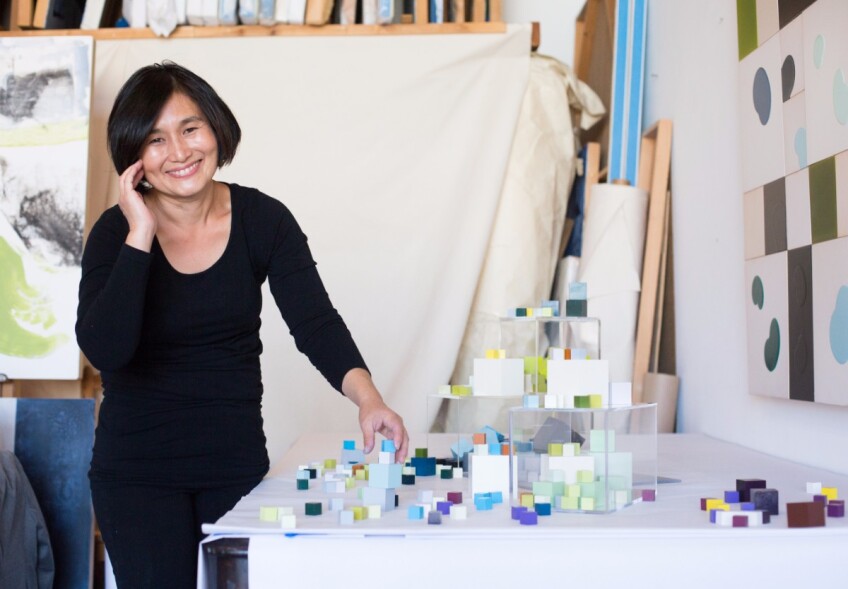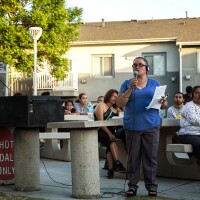One of the City's Oldest Artist Communities Fights to Stay in Arts District

Creativity is one of California’s most important economic assets. The 2017 Otis Report on the Creative Economy has found that California leads the nation with the most number of creative jobs, surpassing New York State, Texas, Florida and Illinois respectively. Yet, these same artists are also faced with the problem of finding a secure, affordable place to live and work. This series of posts on KCET Artbound explores the issue of affordable housing for creative workers.
Tucked away in a heavy industrial area in the southeast corner of Los Angeles sits one of the city’s oldest artist lofts. The Santa Fe Art Colony, a converted garment factory neighboring a cement recycler and meat packing plants, is a world away from the high-fashion boutiques and third-wave coffee shops in the heart of the Arts District just a few miles up Alameda Street.
The art colony has stayed largely insulated from the development that has transformed nearby downtown neighborhoods in recent years. But the same forces that have priced many artists out of the area may have finally reached its door.
In October, a 30-year rent-restriction agreement between the city and the property owners is set to expire. Many of the eighty artists living and working in the 57 studio spaces fear a dramatic rent increase will force them out of their home. The Santa Fe Art Colony is the city’s only rent-restricted property dedicated solely to artist housing; its tenants are now fighting to keep the colony affordable and ensure working artists remain a part of the vibrant downtown community they helped create.
Adams has twice been evicted in LA and saw firsthand how the development boom in New York displaced artists when she lived in SoHo in the early 80s. She says spaces like the Santa Fe Art Colony are vital because they allow artists to join a community that understands their work habits and process.
Sylvia Tidwell, head of the Santa Fe Art Colony Tenant Association, says the property owners gave residents sixth-month notice in March that rents will increase as much 80 percent and in some cases will double. She has spearheaded an effort to find a solution on behalf of the artists, reaching out to city officials, lawyers and arts non-profits for help.
“Artists simply can’t pay these prices, and we would be forced out due to the market pressure of people interested in living in the Arts District,” says Tidwell. “We want to keep the area an authentic arts district with creative artists active and working in it.”

Many of the tenants have lived in the building for decades and say the space, located on the southern edge of the Arts District, has been essential in facilitating their work and careers.
“We’ve made it so it’s like a little oasis down here,” says mixed-media visual artist Sharon Ryan, a tenant for 20 years.
Ryan was drawn to the open layout and expansive walls of the loft, where she could set up her canvases and work tables. The extra space and freedom have made living in a heavy industrial area worth the inconvenience, even when the rancid smell from a nearby meat packing plant wafts into her loft.
“I’m more than happy to live on the edge like this because you can work until 3 or 4 in the morning,” says Ryan. “No one comes asking what you’re doing or telling you you’re too loud.”

“You’re in a group of like-minded people, and you don’t have to explain yourself,” says painter Lisa Adams.
Adams has twice been evicted in LA and saw firsthand how the development boom in New York displaced artists when she lived in SoHo in the early 80s. She says spaces like the Santa Fe Art Colony are vital because they allow artists to join a community that understands their work habits and process.
“It’s very normal to be your individual self,” says Adams. “[Living in a residential neighborhood] doesn’t work because you’re different, and there’s a comfort here in being around those same kind of different people.”
Artists began moving to the downtown area in the 1970s to escape rising rents and dwindling studio space on the Westside. They built illegal lofts in abandoned warehouses and lived together in gritty, blighted neighborhoods that weren’t zoned for occupancy. To address the zoning and safety issues, the city created an Artist-in-Residence program in 1981, allowing artists to live in converted commercial properties and form the neighborhood that would become the Arts District.
In 1986, the Community Redevelopment Agency of the City of Los Angeles (CRA) entered in a 30-year partnership with the owners of a defunct terrycloth-robe factory on Santa Fe Avenue to provide low-interest loans to retrofit the buildings and create rent-restricted artist lofts. The Santa Fe Art Colony was born and quickly became a fixture of LA’s art scene. Previous tenants included renowned artist like Kim Abeles and Sam Durant.
After receiving a one year extension from the city in September 2016, the agreement is now set to expire for the colony’s residents. Tidwell and the tenant association have asked city officials including City Councilmember José Huizar to help find a way to stave off the rent increase. They’ve also set up an online petition to build public support.
“Councilmember Huizar very much supports extending the affordable rent covenants for the Santa Fe Lofts and we are actively working with the residents and their representatives on available options,” said Huizar’s office in a statement. “In the short-term, our office secured an extension to the lease. And we have asked our City's Housing Department (HCID) to exhaust all remedies to see if they can secure a long-term extension with the current owner.”

According to Tidwell, the property owners have shown little interest in reaching a new affordability agreement. In response, the association has assembled a group of outside investors and is prepared to make a bid to purchase the property if necessary. The group argues that, according to the state code, it has a right to effectively force a sale of the property if the current owners decline to enter into a new agreement.
The property owners, through their legal representation, declined to comment for this article.
“Having artists that can have equity stakes in projects is really what can ensure long-term affordability and permanency of affordable spaces for artist communities,” says Teri Deaver, a vice president at the real estate development nonprofit Artspace, who has consulted with the tenant association.
Deaver stresses that artists represent a diverse cross-section of low-income populations, including veterans, immigrants and differently-abled people. She says that affordable, artist-operated live/work spaces can spur entrepreneurship among these groups, and that their contributions to local communities are far reaching.
According to the 2017 Otis Report on the Creative Economy, 1 in 8 private workers in the Los Angeles area worked in creative industries in 2015, generating over $190 billion in total economic output. While the report takes into account a range of industries like architecture and fashion, that shouldn’t diminish the role fine artists play in influencing LA’s creative sector.
Each year, the colony’s residents hold an art walk and open their studios to the public, which is well attended by Hollywood producers, set designers and art directors.
“They’re looking at the artists because that’s where it all starts,” says designer and builder Tom Villa, who invites visitors into his studio during the art walks. “There’s a giant economic impact that people don’t always understand and there’s no way to quantify.”

The same report from Otis also included an addendum written by Deaver, which emphasized the need to provide affordable housing, especially in regions such as the San Francisco Bay Area and Los Angeles that have some of the highest real estate costs in the country. Deaver writes, “Without the creation and retention of affordable housing and live/work space for the creative sector, California’s unique culture and businesses, which rely on a steady pool of artistic and creative talent, will suffer. Educational institutions that seek to train the next generation of California creatives will watch graduates leave and invest their talents elsewhere. Every city, town, and business that relies on the output and impact of the creative economy and access to a healthy creative workforce should be concerned about the availability of affordable and appropriate space to incubate emerging talent and retain a competitive pool of creative workers.”
With multi-million-dollar development projects being green-lit at historic levels in the downtown area, it’s easy to assume the city has discounted the value of its artist class in favor of a rapid urban renewal. But nobody wants to see an Arts District without any artists. And Tidwell believes there is plenty of incentive for city officials to help keep the Santa Fe Art Colony intact, which in turn would be a major step in ensuring L.A. remains a city where artists can live, work and thrive.
“Work-a-day artists generate ideas that inspire the culture,” says Tidwell. “It’s essential for a society to have that kind of explosive creativity, especially here in L.A.”
Walk inside the Santa Fe Art Colony live-work spaces with these 360 videos:

